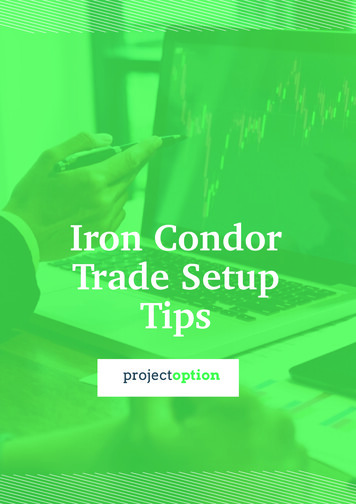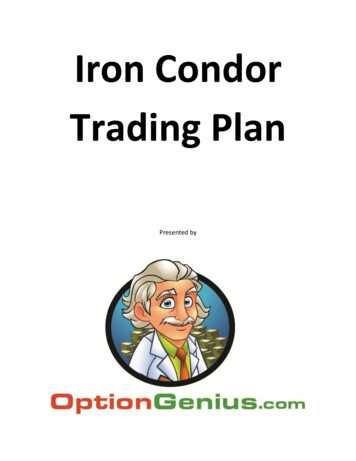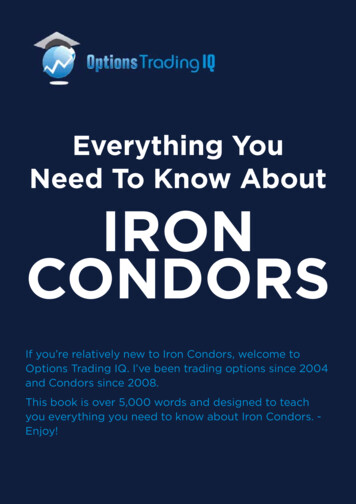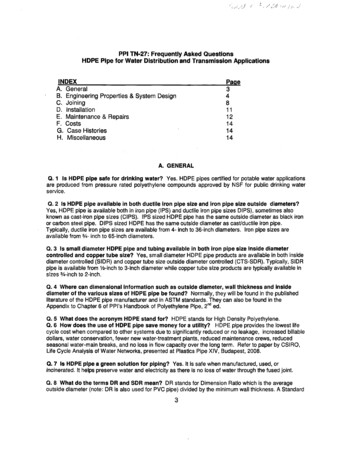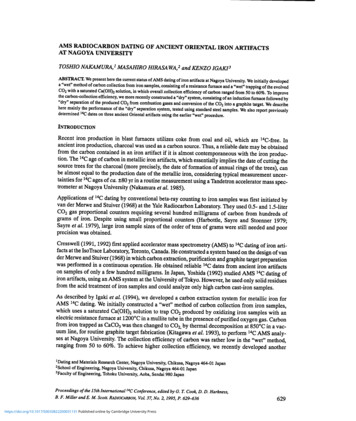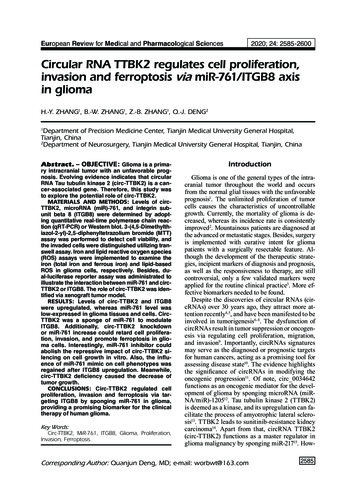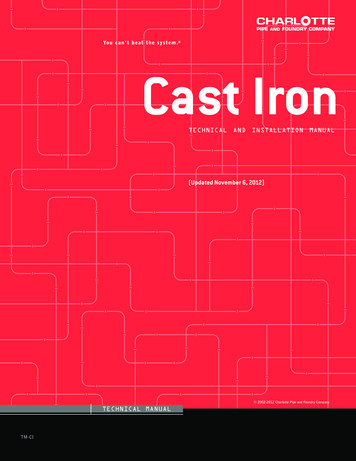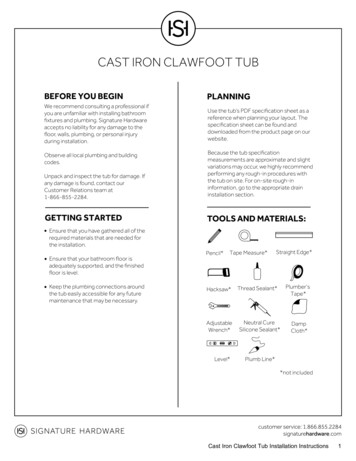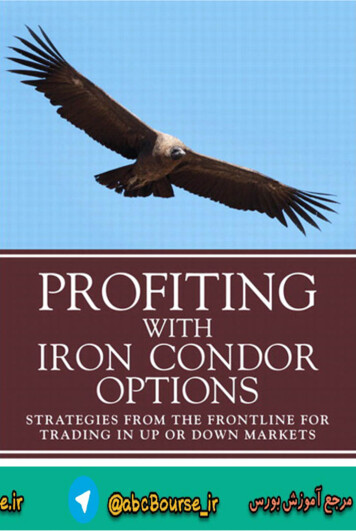
Transcription
PROFITINGWITHIRONCONDOROPTIONSSTRATEGIESFROM THEFRONTLINE FOR TRADING INUP OR DOWN MARKETSMI C H A E LBHA N A N I AE N K L I F A
Vice President, Publisher: Tim MooreAssociate Publisher and Director of Marketing: Amy NeidlingerExecutive Editor: Jim BoydEditorial Assistant: Pamela BolandDevelopment Editor: Russ HallOperations Manager: Gina KanouseSenior Marketing Manager: Julie PhiferPublicity Manager: Laura CzajaAssistant Marketing Manager: Megan ColvinCover Designer: Chuti PrasertsithManaging Editor: Kristy HartProject Editor: Anne GoebelCopy Editor: Cheri ClarkProofreader: Linda SeifertIndexer: Lisa StumpfCompositor: TnT Design, Inc.Manufacturing Buyer: Dan Uhrig 2011 by Pearson Education, Inc.Publishing as FT PressUpper Saddle River, New Jersey 07458This book is sold with the understanding that neither the author nor the publisher is engaged inrendering legal, accounting, or other professional services or advice by publishing this book.Each individual situation is unique. Thus, if legal or financial advice or other expert assistanceis required in a specific situation, the services of a competent professional should be sought toensure that the situation has been evaluated carefully and appropriately. The author and thepublisher disclaim any liability, loss, or risk resulting directly or indirectly, from the use orapplication of any of the contents of this book.FT Press offers excellent discounts on this book when ordered in quantity for bulk purchasesor special sales. For more information, please contact U.S. Corporate and Government Sales,1-800-382-3419, corpsales@pearsontechgroup.com. For sales outside the U.S., please contactInternational Sales at international@pearson.com.Company and product names mentioned herein are the trademarks or registered trademarks oftheir respective owners.All rights reserved. No part of this book may be reproduced, in any form or by any means,without permission in writing from the publisher.Printed in the United States of AmericaFirst Printing January 2011ISBN-10: 0-13-708551-6ISBN-13: 978-0-13-708551-4Pearson Education LTD.Pearson Education Australia PTY, Limited.Pearson Education Singapore, Pte. Ltd.Pearson Education Asia, Ltd.Pearson Education Canada, Ltd.Pearson Educatión de Mexico, S.A. de C.V.Pearson Education—JapanPearson Education Malaysia, Pte. Ltd.Library of Congress Cataloging-in-Publication Data:Benklifa, Michael Hanania.Profiting with iron condor options : strategies from the frontline for trading in up or downmarkets / Michael Hanania Benklifa.p. cm.Includes index.ISBN-13: 978-0-13-708551-4 (hardback : alk. paper)ISBN-10: 0-13-708551-61. Options (Finance) 2. Stock options. I. Title.HG6024.A3B46 2011332.63’2283—dc222010040117
Pour ma mère,For my beautiful wife Adira,and for my wonderful childrenYehudah, Shimon, Chana, and Chaim
This page intentionally left blank
Table of ContentsForeword .viiiAcknowledgments . .xAbout the Author . .xiiPreface. .1Chapter 1: The Horse Race . .7Too Good to Be True .8Introduction to Trading .8How Options Work .11The Horse Race.12First Lap .12Second Lap .13Third Lap .13Final Stretch .13And the Winner Is .13Buying Versus Selling .16The Buyer .16The Seller .18Trading the Math .24Time Is Money—Theta .26Volatility: Everything Else .34CSI: Condor .40American- and European-Style Options .50Hedging Effect .51The Volatility Gap .53
viProfiting with Iron Condor OptionsChapter 2: Placing a Trade .59Two Out of Three .60Time .63Position .68Fundamentals .69Charts . .71Delta . .75Price .80Putting It Together .83Why Enter a Trade? .85Rules for Putting on a Trade .89Sideways Market .91Uptrending Market .92Downtrending Market .98Shape of the Curve .98Chapter 3: Trading Journal .105Staying Through Expiration .106Expiration Friday . .108Parameters for Exiting a Trade .109Adjustments . .111Journal of Actual Trades.111The Perfect Trade . .112Sideways Market . .112Great Trade in a Down Market .118Not-So-Pretty Trade . .121Everything Goes Wrong . .124
Table of ContentsviiUgly Trade—Crash of 2008 .136Trading an Out-of-Control Rally .144Risk Management . .148Take the Loss .148Reduce Your Exposure .149Wing Buyback .149Chapter 4: Day Trading Condors .151A Little About Earnings .152The Perfect Setup and Trade .157The Process .163Next Morning.170Important Announcements .172Index . .175
ForewordOption traders have an advantage over otherinvestors because they can structure positionsthat generate a profit regardless of the directionof movement of the underlying security. Many of thesetrades generate their maximum profit if the underlyingstock remains motionless for an extended period oftime. Condor is such a trade. Simply stated, condorsgenerate large profits when the underlying securityremains range-bound for the duration of the trade.Properly structured condors can absorb large marketchanges and still generate impressive profits.This characteristic has made condors one of themost popular trades among knowledgeable investorswho have discovered the benefits of not betting on thedirection of anything. Their view is exactly oppositethat of a stock picker who spends all his time searchingfor “underpriced” securities that can be purchasedbelow fair value. Condor traders assume that the market knows the fair value of a stock or index, and that itwill continue to trade close to the current price untiladditional news generates a distinctly different view.Moreover, because option prices are based on volatility,they normally comprehend the effects of such news. Aknowledgeable option trader, therefore, should be ableto structure profitable condors in most markets.
As always, the devil is in the details. If structuringprofitable condors was easy, everyone would be rich;there would be nothing to write about, and this bookwould collapse into a single page with a bulleted list ofrules. But nothing could be further from the truth.Condors have four moving parts that are each affectedby time and volatility. Volatility, in turn, has a structurethat varies according to strike price and expiration date.It often rises or falls in a complex pattern that can bedifficult to understand. Writing these words causes meto remember a conversation with Michael where hepointed out that the trade is somewhat asymmetricalbecause volatility falls in a rising market but rises in afalling market. Adjustments on the call side should,therefore, be handled differently than adjustments onthe put side. That little nugget of gold and its associateddetails are just one of hundreds contained in this book.Just a few years ago, private investors could dabblein the market and still make money. Those days aregone forever. Today’s complex markets are a challengefor even the most sophisticated investor. Successful trading strategies are built around complex trade structures,careful risk management, a detailed understanding ofhow the market responds to news and events, and precise timing. This book explores all those topics andmore for one of the most popular trade structures.More importantly, it represents the accumulated knowledge of many years of trading with millions of dollars inone of the most turbulent markets in history.—Jeff AugenAuthor of Trading Options at ExpirationDecember 2010
AcknowledgmentsFirst, I’d like to thank my Creator who makes allthings possible. I never forget (Devarim 8:11-18).A book like this happens because many people along theway helped me get to where I am. I want to thank DavidGoldberg, Joseph Benporat, and Shelly Rosenberg foropening the door and helping me get through it. OscarRosenberg, Fred Todd, Miky Goldschmiedt, SusanDiamond, and David Schwarcz for having faith and confidence in my abilities and, literally, pushing me into this.Thanks, Susan, for all the opinions, ideas, articles, andsupport. Steve Lentz for always being there to answerthe tough questions. Frank Fahey for his insights anddirection. Alex Lushtak and Anatoly Tikhman for givingme a chance. Gene Lushtak who still can explain what Ido better than I can. To my wonderful in-laws Steve andCarolyn Kayne for being the perfect “average investors”for me to test my ideas. Jim Boyd at FT Press who actually understands options and for giving me this opportunity. Michael Thomsett for doing a fantastic editing joband saving me from myself.David Lehrfield for great execution of trades, for disagreeing with me constantly, and for being a greatfriend. You’ll find a lot of you in this book.
I’d especially like to thank my Options Guru, Jeff Augen,on a number of levels. Not only would this book havenot come to fruition without his direct involvement, buthe profoundly changed the way I think and approachoptions as a trader. Read his books and be transformed.I look forward to the day when you ring the bell.Finally, without the patience and encouragement of mywife Adira and my kids Yehudah, Shimon, Chana, andChaim, I never would have finished the book.Thanks one and all!
About the Authorichael Hanania Benklifa manages millions ofdollars worth of condor trades every monthfor private investors through his firm, OthelloConsulting. He formerly served as a Financial Advisorfor UBS and as an M&A Analyst for several large pharmaceutical companies. Benklifa holds an MBA fromTexas A&M, as well as a Diplôme (Masters inManagement) from École Supérieure de Commerce inFrance, and a BA in Philosophy from the University ofTexas.M
PrefaceIused to hate trading. The problem with stock trading is that you have to know too much in order tobe correct, or you have to trade on blind faith.People buy and sell stock every day without having theslightest idea about the company or the stock they aretrading.A while back I used to work in Mergers andAcquisitions. My job was to determine the viability ofbusinesses for acquisition by large corporations. Let’sscale it down and say you have 100,000 and you wantto buy a small business. What kinds of things do youwant to know about that business? You need to look atthe books and track revenues, profits, and expenses.But to buy a business solely on that information wouldbe foolish.You also want to know about the competition, market share, number of competitors, and competitiveadvantage. Without an understanding of the competitors and who they are, you don’t really have a grasp ofthe future of the company.There’s more. Who are the suppliers? What contracts exist? Who else do they supply? The supply lineis crucial for the bottom line.There are even more questions about the employees.You need to know who is indispensable and who isn’tand what kind of employment contracts are in place. Youneed to talk to the sales staff and marketing departmentto get their perspective.
2Profiting with Iron Condor OptionsThere are many more questions you should askabout a business before investing. Yet almost everybodywho invests in stocks cannot answer the most basicquestions about a company. Pick your favorite company. Can you name its five biggest competitors? Howabout the main suppliers? Would you buy a business byjust looking at charts? Usually just those few questionsare enough to stop people cold. Still, people will puttheir life savings on a name about which they reallyknow nothing.Who actually knows the answers to those questions?Maybe there are things about the company that fulltime experts know and that you never will know. Eventhose experts still will get it wrong some of the time.So I hated trading because I didn’t believe I had theconfidence to make sound decisions that wouldn’t justbe guesses at the end of the day. I was a FinancialAdvisor and people were always asking me about whatI thought about the market or whether I had a goodstock tip. It wasn’t too impressive to say, “I don’tknow,” but it was an honest answer. I mostly recommended Structured Products, hybrids of stocks, options,and bonds designed for hedging risk. Some of thoseStructured Products were unfortunately issued andguaranteed by venerable institutions like LehmanBrothers. The more I learned about these products, themore I started to learn about the intricacies of options.What appealed to me about options was that therewere strategies that worked even if you didn’t knowanything about the company whatsoever. You didn’teven need to know whether the price was going to go up
Preface3or down. In fact, the trade had nothing to do with eitherthe company or the price. It had to do with the fear builtinto the price and how much time was left until expiration. The actual ticker was irrelevant. So now I realizedI could trade without having an opinion.Over time, I worked on and studied various optionsstrategies and adopted condors as my favorite. Thereare a number of ways to trade this strategy and I triedthem all. The strategy presented in this book is the onethat I find works best in a variety of market conditions.In the very difficult market conditions of the past fewyears, I’ve managed to generate pretty decent returns ona regular basis. Don’t be surprised if your returns are inthe 30% to 60% range in a year. No guarantees, but itcan be done.There are a few questions I’m always asked after Iexplain what I do. The first is always, “What’s therisk?” The second is, “Why have I never heard aboutthis before?” The third is, “Why doesn’t everybody dothis?”As to the first question, I always describe the riskynature of the trade. There is a lot of risk in this trade.Everybody should consider the nature of the trade andhow much they are willing to risk and who they arewilling to risk it with. Results count. I’m generally farmore risk averse than I am for the clients whose capitalI trade.“Why have I never heard about this before?” Theanswer to this question is not so simple. The ordinaryinvestor either is trading his own stocks or has handeda portfolio over to an advisor to manage for him.
4Profiting with Iron Condor OptionsAdvisors by and large don’t really want anything to dowith options. What they do understand about options isgenerally very limited, and their approach is pretty simple. They trade them like stocks. Buy this or that optionand see what happens at expiration. The other officiallycondoned strategy is covered calls. Additionally, myexperience at large firms is that they actually dissuadeadvisors from trading options in any sophisticated manner. There are generally no tools on the system to doproper analysis of options even if they wanted to tradeeffectively. I was told by a chief options strategist at amajor brokerage that they don’t want their advisorstrading options because they are worried about big mistakes. That is a smart decision on their part but trulylimits what you as a trader and investor can do to earnmoney and protect your assets.Additionally, sophisticated option trades require constant supervision. An easy trade needs no attention, butyou can never tell which one is an easy trade until youare done. Markets can move on a dime and you have tobe ready to respond. Unless you have the luxury to payattention to the market and place orders when necessary,you could increase your risk in a trade substantially.The last question is, “Why doesn’t everybody dothis?” This has a few different answers. First is the poorexperience investors have had with options in the past.Most of those burned by options have lost money buying options, which is all too often a sucker’s bet. Secondis a genuine lack of education and understanding ofoptions and particular strategies, which this book seeksto help remedy. The third answer is that no one will do
Preface5this job for you. Your advisor will not manage optionsstrategies for you because there is not enough money inthis for him relative to the risk involved. He will notmonitor it because he has 100 other clients for which hehas to make financial plans. Mutual funds don’t do thisbecause it’s not in their charter. Hedge funds are too big.They can’t just step up and start spending a billion dollars in the options market.Many people have asked me why I’m giving away mystrategy. They wonder, wouldn’t that ruin its effectiveness?First of all, I didn’t invent condors nor am I reinventingthe wheel. This is a merely a strategy and not a formula.Think of it as a method or an approach to trading condors. What’s missing for a lot of traders or people whowould like to trade options is a proper understanding ofhow options really work. There are a lot of moving partsto track. I imagine stock trading akin to flipping a coin.Options trading is more like playing chess.Two caveats before going forward:Caveat #1: By their very nature, condors are highrisk strategies. They can blow up on you and youcan lose all or most of the money you put up in thetrade. This book takes that possibility into accountand points out ways to diminish but not eliminatethe risk. You will learn that picking the right instrument to trade, picking the size of your condor,strategically choosing your entry and exit points,limiting your time in the market and, especially, notgetting greedy will all help to mitigate risk. But thereis always the possibility of total failure regardless ofall the risk management in the world.
6Profiting with Iron Condor OptionsCaveat #2: This is not an income strategy. In orderto entice people to attend classes or buy books,many people would call this an income-generatingstrategy because of how successful it can be on aregular basis. But calling this an income strategy ismisleading and inaccurate.An options condor is a trade. That’s it. No more andno less. If you start thinking of this as an incomestrategy or, worse still, depending on it for yourincome, you will lose all of it. You will push thisstrategy too far and too hard and the condor willswoop down and eat you alive.Caveats aside, I absolutely love trading condors. I’vemade a lot of money for myself and my clients eventhough I’ve also had many sleepless nights. However,making money is never easy and never without risk.Still, there is a certain pride about making stellar returnseven when I am wrong about market direction.A condor is a big bird with a wingspan that canreach 10 feet. When it flies, it flaps only occasionallyand glides most of the way. The silent, patient image ofthis lovely bird floating through time and space willprovide a useful metaphor for the trade you will learn.Like the flapping of its wings, the opening and closingof a condor trade should be done infrequently. Thepatient drift through calm air reflects the slow andsteady time decay and the low volatility that will lift ourprofits. Treat this awesome bird with the respect itdeserves and you can ride on its wings.
Chapter 1The Horse RaceAn iron condor is a complex options trade thatcreates a “zone,” as illustrated in Figure 1.1, inwhich a profit occurs over time and within aspecific price range. Correctly picking the direction ofprice movement is not necessary. Understanding thedynamics involved in the trade is the key to long-termsuccess and limited risk.Source: OptionVue 6FIGURE 1.1S&P 500 Index chart7
8Profiting with Iron Condor OptionsToo Good to Be TrueToo many people trade options without knowing aboutthe range of risks they face, or without first acquiringthe knowledge they need. This book addresses thatproblem with respect to condor trading. Nonetheless,condors are lucrative and you can create profits quiteeasily; but you can also lose money in a condor trade.Condors are the most consistently profitable trade youcan create, with potential annual returns reaching 30%,40%, 50%, or more if put together correctly.Just as there are different ways to play chess, thereare different strategic methods for trading options. Thisbook presents a conservative strategy designed to maximize gains and minimize risk.Introduction to TradingIronically, with condor trading, having an opinionabout a company or the direction of the market is theeasiest way to lose money. The more convinced you arethat your opinion is correct, the more you’ll hold ontoa losing position and ignore the realities, not of thecompany but of your trade. A wise investor namedBernard Baruch once said that the main purpose of thestock market is to make fools of as many people as possible. The best response to this advice is to not have anopinion.There are very few places where not having an opinion is actually profitable, and surprisingly the optionsworld is one of those places. Some options strategies are“market neutral,” meaning their potential to generate a
The Horse Race9profit is not dependent on whether the market goes upor down. Actually, these market-neutral strategies dobest when the market moves up and down within agiven timeframe.Once upon a time, a myth was perpetuated that allyou had to do was keep your money in the stock market and you would get rich and retire. This assumptionwas considered so obvious that something called an“Individual Retirement Account,” or IRA, was createdso that people could put their money in the stock market and benefit from tax incentives. The fundamentalproblem with this way of thinking is that people forgotthat the stock market is a place of investment with all ofits associated risks and dangers. It is not a retirementaccount. After the 2008–09 crash in the market, mostpeople are now painfully aware of this fact. The buyand-hold strategy is not guaranteed to create wealth.Investing also presents you with a huge obstacle,namely, acquiring and applying knowledge. Do youreally know more than the stock market? If Apple ispriced at 200, you need to know something thatnobody else knows in order to believe that the markethas mispriced Apple and that the company should beworth either much more or much less. Actually convincing yourself that you have an edge against full-time professionals with their massive supercomputers and theirteam of Ph.D. programmers is delusional. Chances areif you do make money investing in the market, you arelikely riding the wave that is making everybody elsemoney as well—in other words, you got lucky!
10Profiting with Iron Condor OptionsThere is another way to make money in the stockmarket that has nothing whatsoever to do with investing: trading. Investing requires, or at least shouldrequire, research, understanding, careful analysis, andstrategy regarding a company and its sector. Trading issimply about making money. The shorter the timeframeinvolved in the trade, the less significant fundamentalinformation and all the accompanying researchbecomes.Swing traders like to trade in a timeframe of days orweeks. Day traders like to trade in a timeframe of hoursor minutes or even seconds. Now computers areinvolved in high-frequency trading (HFT), which movesmoney in and out of positions in millionths of a second.Computers have taken any kind of qualitative edgeaway from human traders. They can process all relevantnews and information and trade accordingly before thenerves in your eyes can electrically send the visual information of the words you just read to your brain.There is one domain where computers will not driveout the human competition. That is the world ofoptions trading. Options traders observe and rely on themarket’s emotions, fear, and panic, and design theirmoves to maximize or minimize the effects of time.Increased fear means increased prices in options, anddecreased fear means lower prices. Although computershave been programmed to exploit mispriced options inan instant, fear is something computers don’t understand yet.
The Horse Race11How Options WorkOptions can be thought of as the Swiss Army knife oftrading. The combinations and maneuvers available inoptions trading strategies seem endless. By comparison,stock trading is a simple directional trade. The decisionto buy or sell a stock is usually done through fundamental analysis or technical charting techniques. Optionstraders look at these tools and so much more.This section is not meant to be an introduction tooptions, but rather an introduction to options trading.Most options books focus a great deal on comparingcompletely different options strategies and on whathappens at the end of an options trade. A skilledoptions trader, however, might be in and out of thetrade several times before expiration.In this book the focus is more on practical tradingstrategies and less on theory. It’s not what you know, it’s“how” you know it. Your significant paradigm shift isto think like traders and not like investors.Summarizing some of the basics of options trading isa good starting point for the following review. Thisreview is not meant to be comprehensive but, rather, toserve as an approach that shows you what you need toknow in order to get going. Even if you already havesome ideas about how options work, the following discussion might still give you food for thought.
12Profiting with Iron Condor OptionsThe Horse RaceThe following analogy gives you a mind-set for optionstrading. Picture a horse race in which you place yourbet. The value of your bet depends on the odds. If yourhorse is a 2-1 favorite, your chances of winning are highbut you won’t make much money. If the horse you pickis 100-1, your chances of winning are remote but if youdo win the payout will be huge.So you go to the horse race and you bet on yourfavorite horse, SeeBo, who is rated at 100-1, to win.The race is four laps, and as it begins you wait to seewhether you will win or lose at the end. Pretty straightforward so far.Now add a twist to make this race more interesting.You can buy or sell your bet during the race. If you arethe kind of person who just likes to wait until the endof the race, then this twist changes nothing. If you arethe kind who likes to take advantage of a positive development or if you are risk averse, this new dynamicchanges everything, making it literally a whole newhorse race.Run through the possibilities to get a better pictureof the complexities this twist adds.First LapAfter the first lap, SeeBo, surprisingly, is in the lead. Youhold a bet in your hand that could b
Profiting with iron condor options : strategies from the frontline for trading in up or down markets / Michael Hanania Benklifa. p. cm. Includes index. ISBN-13: 978--13-708551-4 (hardback : alk. paper) ISBN-10: -13-708551-6 1. Options (Finance) 2. Stock options. I. Title. HG6024.A3B46 2011 332.63'2283—dc22 2010040117
